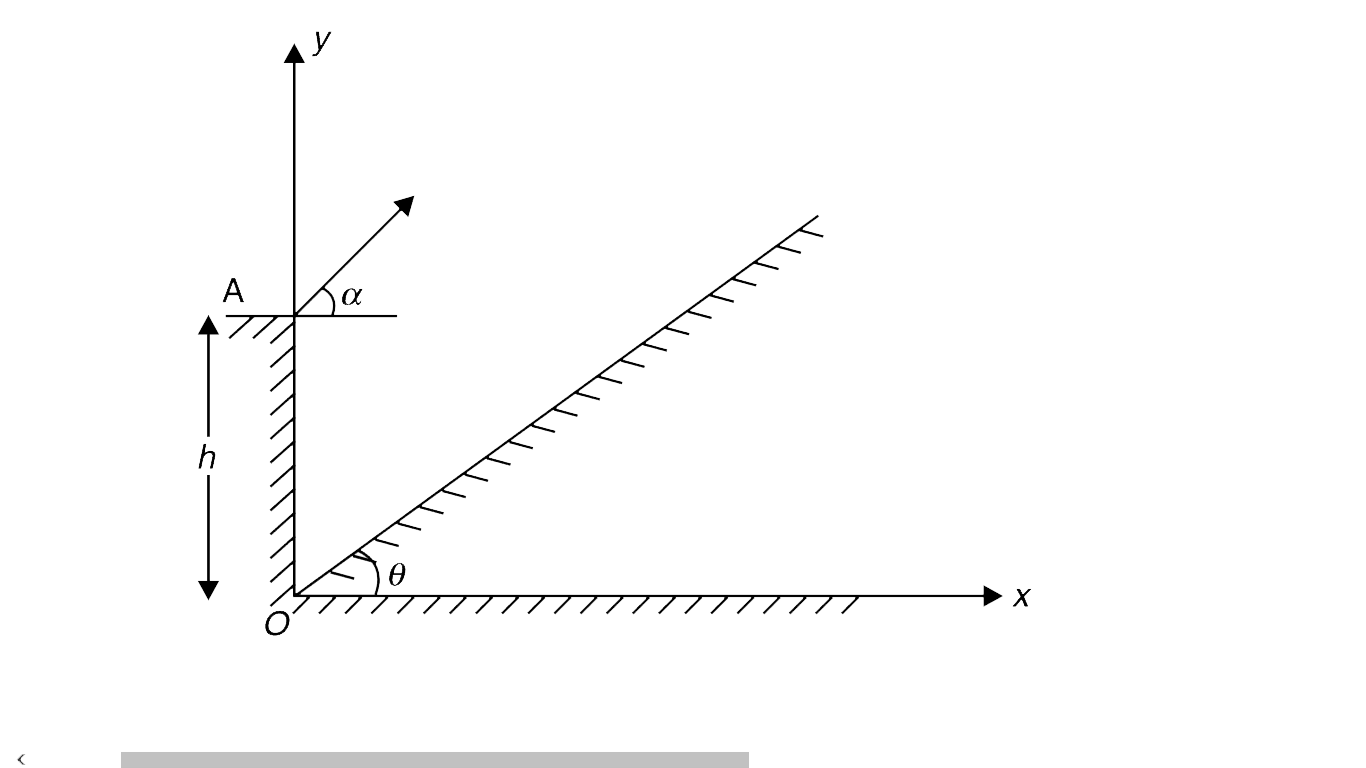A ball is shown at an angle θ up to the top of a cliff of height L, from a point at a distance. L from the base, as shown in figure. Assuming that one of the following quantities is the initial speed required to make the ball hit right at the edge of the cliff, which one is it :-

√gL2(tanθ−1)
1cosθ√gL2(tanθ−1)
1cosθ√gL2(tanθ+1)
√gL2(tanθ+1)
The correct Answer is:B
Step by step video, text & image solution for A ball is shown at an angle theta up to the top of a cliff of height L, from a point at a distance. L from the base, as shown in figure. Assuming that one of the following quantities is the initial speed required to make the ball hit right at the edge of the cliff, which one is it :- by Physics experts to help you in doubts & scoring excellent marks in Class 12 exams.
Updated on:21/07/2023Topper's Solved these Questions
Similar Questions
A small sphereical ball is released from a point at a height h on a rough track shown in figure. Assuming that it dow not slip anywhere, find its linear speed when it rolls on the horizontal part of the track.

View SolutionA uniform thin rod of length 3L is bent at right angles at a distance L from one end as shown in Fig. If length of rod is 1.8m, find the co-ordinates and position vector of the mass of the system.

View Solution
Knowledge Check
A ball is thrown from a point in level with velocity u and at a horizontal distance r from the top os a tower of height h.
How must the speed and angle of the projection of the ball be related to r in order that the ball may just go grazing the top edge of the tower ? Agr=u2sin2θBgr=u2sinθCgr=u2cos2θDgr=u2cosθ
Agr=u2sin2θBgr=u2sinθCgr=u2cos2θDgr=u2cosθA ball is thrown from a point in level with velocity u and at a horizontal distance r from the top of a tower of height h.
At what horizontal distance x from the foot of the tower does the ball hit the ground ? Aucosθg{(u2sin2θ+gh)1/2−usinθ}Bucosθg{(u2cos2θ+2gh)1/2−ucosθ}Cucosθg{(u2cos2θ+gh)1/2−ucosθ}Ducosθg{(u2cos2θ+gh)1/2−ucosθ}
Aucosθg{(u2sin2θ+gh)1/2−usinθ}Bucosθg{(u2cos2θ+2gh)1/2−ucosθ}Cucosθg{(u2cos2θ+gh)1/2−ucosθ}Ducosθg{(u2cos2θ+gh)1/2−ucosθ}A ball of mass m is released from A inside a smooth wedge of mass m as shown in figure. What is the speed of the wedge when the ball reaches point B?
 A(a) (gR3√2)1/2B(b) √2gRC(c) (5gR2√3)1/2D(d) √32gR
A(a) (gR3√2)1/2B(b) √2gRC(c) (5gR2√3)1/2D(d) √32gR
From the top of a cliff of height 150 m, a stone is thrown up with a velocity of 19.6m/s, at an angle of 60∘ with the vertical . Calculate the distance of the point where it strickes on the ground from the foot of the cliff .
View SolutionA ball is projected downward from the top of a cliff of height h with an initial speed v.Another ball is simultaneously projected vertically up from the bottommost of the cliff with the same speed.When do they meet?
View SolutionA ball is projected from a cliff of height h=19.2 m at an angle a to the horizontal. It hits an incline passing through the foot of the cliff, inclined at an angle θ to the horizontal. Time of flight of the ball is T=2.4s. Foot of the cliff is the origin of the co-ordinate system, horizontal is x direction and vertical is y direction (see figure). Plot of y co-ordinate vs time and y component of velocity of the ball (vy) vs its x co-ordinate (x) is as shown. x and y are in m and time is in s in the graph. [g=10m/s2]


(a) Find the angle of projection a
(b) Find the inclination (θ) of the incline.
(c) If the ball is projected with same speed but at an angle θ(= inclination of incline) to the horizontal, will it hit the incline above or below the point where it struck the incline earlier?
View SolutionIf a stone is to hit at a point which is at a distance d away and at a height h (see fig) above the point from where the stone starts,then what is the value of initial speed u if the stone is launched at an angle θ?

View SolutionFrom an inclined palne two particles P,Q are projected with same speed at same angle θ,one up and other down the plane as shown in figure.Which of the following statement(s) is/are correct ?

View Solution

